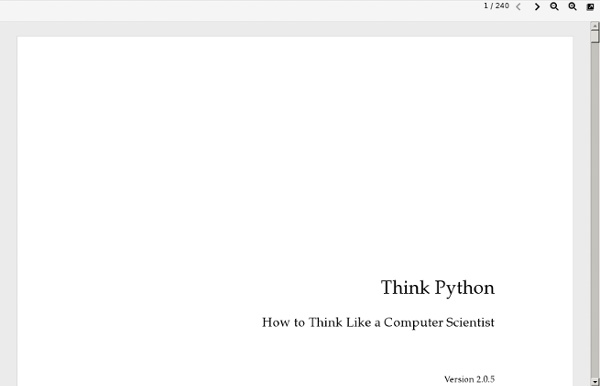



Orange – Data Mining Fruitful & Fun Python Course: Tutorial, Reference and Advanced Topics Tutorial More than a HOWTO, this document is a HOW-DO-I use Python to do my image processing tasks. Image processing means many things to many people, so I will use a couple of examples from my research to illustrate. Introduction Basic Software I am going to assuyme that you have installed the following: Python 2.5, 2.6, or 2.7 (avoid 3.0 or 3.1---too new) numpy scipy matplotlib ipython Under Linux, you can just install your distribution's packages (install at least python-numpy, python-scipy, python-numpy-dev, python-matplotlib, ipython). Other Software You should also download and install: pymorph mahotas The first package contains morphological code. First Task: Counting Nuclei Our first task will be to take this image and count the number of nuclei (you can click on the image and download it to try this at home): Before we start, let us import the needed files. import numpy as np import scipy import pylab import pymorph import mahotas from scipy import ndimage dna = mahotas . imread ( 'dna.jpeg' )
Online Python Tutor - Learn programming by visualizing code execution Dive Into Python Python Resources | edX Wiki Skip to this view's content Please enter your e-mail address below, and we will e-mail instructions for setting a new password. Help Have general questions about edX? You can find lots of helpful information in the edX FAQ. Have a question about something specific? Report a problem Make a suggestion Ask a question Please note: The edX support team is English speaking. Thank you for your inquiry or feedback. We're Sorry, edX accounts are unavailable currently The following errors occurred while logging you in: Your email or password is incorrect Please provide the following information to log into your edX account. Required Information Account Preferences
Second Try: Sentiment Analysis in Python : Andy Bromberg Introduction After my first experiments with using R for sentiment analysis, I started talking with a friend here at school about my work. Jackson and I decided that we’d like to give it a better shot and really try to get some meaningful results. We also met with Christopher Potts, a professor of linguistics here at Stanford. If you’d like to jump straight to seeing the full code, you can head over to the GitHub repository. The Setup One of the resources we got a lot of mileage out of was StreamHacker, especially the articles on basic techniques, precision and recall. and eliminating features. Another great discovery was the Natural Language ToolKit (NLTK). During our first attempt, we basically just tried to convert my program in R into Python. An important piece of sentiment analysis terminology: “features” are whatever you’re analyzing in an attempt to correlate to the labels. As an aside, here are the imports we used for the project, so I won’t have to reference them again: Addendum
CPython Compilers Getting started with Python: Tips, Tools and Resources - Lesson in Programming 1. MIT 6.00x: Introduction to Computer Science and Programming 6.00x is an introduction to using computation to solve real problems. The course is aimed at students with little or no prior programming experience who have a desire to understand computational approaches to problem solving. This is an amazing course! 2. This course is designed to help students with very little or no computing background learn the basics of building simple interactive applications. 3. This course introduces the fundamental building blocks of programming and teaches you how to write fun and useful programs using the Python language.
Machine Learning in Python Has Never Been Easier! « The Official Blog of BigML.com At BigML we believe that over the next few years automated, data-driven decisions and data-driven applications are going to change the world. In fact, we think it will be the biggest shift in business efficiency since the dawn of the office calculator, when individuals had “Computer” listed as the title on their business card. We want to help people rapidly and easily create predictive models using their datasets, no matter what size they are. Our easy-to-use, public API is a great step in that direction but a few bindings for popular languages is obviously a big bonus. Thus, we are very happy to announce an open source Python binding to BigML.io, the BigML REST API. The BigML Python module makes it extremely easy to programmatically manage BigML sources, datasets, models and predictions. Just like magic! We have tried to build a very simple binding just wrapping all the HTTP requests and responses to BigML.io within one class. Beautiful Models: See our former post about it. Like this: